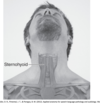Laryngeal Structures and Muscles W3 Flashcards
(35 cards)
what is the larynx?

approx 5cm in length etending from the 3-4th to 6th cervical vertebra primary biological functions include guard do to the airway during swallowing allows pressure build up for physical exertion - hold breath modifies upper airway resistance secondary function - phonation for speech
what are the laryngeal cartilages?
major unpaired cartilages: thyroid, cricoid, epiglottis
smaller paired cartilages: arytenoid, corniculate, cuneiform
what is the epiglottis?

flexible elastic leaf like cartilage
flips during swallowing to assist airway protection
attached just below thyroid notch via thuroepiglottic ligament
what is thyroid cartilage?

largest and most superior laryngeal cartilage
thyroid lamina
thyroid notch
laryngeal prominence - adams apple
superior horns
inferior horns
oblique line

what is cricoid cartilage?

sits just below the thyroid cartilage, and just above the superior tracheal cartilage
shaped like a signet ring - anterior aspect is lower than posterior
posterior superior portion articulates with the srytenoid cartilages
lateral edge articulates with the inferior horns of the thyroid cartilage
cricoid arch, laminae, cricothyroid joint - articular facets for inferior thyroid cornu, median vertical ridge

what is arytenoid cartilages?

small cone shpaed cartilages paired
sit on top of cricoid cartilage
three processes - apex, muscular and vocal processes (vocal folds)
what are the cricothyroid and cricoarytenoid joints?
only functionally mobile points of the laryn
crucial for speech production
cricothyroid - changes in vocal pitch
cricoarytenoid - adduction and abduction of vocal folds (vocal fold vibration) required for phonation
what is the cricothyroid joint?

allows thyroid to rock downwards given shape of cricoid
allows thyroid to glide forward and back slightly
when these two structures approximate in the front the thyroid and arytenoids move further apart tensing the vocal folds - provides major adjustment for change in pitch

what are the cricoarytenoid joints?
allows rocking and gliding and some rotation of the arytenoids on the cricoid cartilage
rocking = approximation of vocal fgolds
gliding = changes in vocal fold lenth
rotation = extremes of abduction
provides the adduction and abduction required for phonation or voice
what is vocal fold abduction and adduction
adduction = vocal processes rotated medially and inferiorly
abduction = vocal processes rotated superiorly and laterally

what are the corniculate cartilages?

conical shaped cartilages that sit on the apex of the arytenoid cartilages
continuation of the arytenoid cartilages i.e. forms an apex on the apex

what is cuneiform cartilages?

situated in the aryepiglottic folds
cant be directly visualised
seen by presence of cuneiform tubercles

what is the hyoid bone?

horseshoe shaped
situated at the level of c3 - important structure for swallowing
body
greater horns
lesser horns
does not articulate with any other bone - held in position by a muscular sling
what is the difference between intrinsic and extrinsic laryngeal muscles?
intrinsic have both their origin and insertion on laryngeal cartilages, fine adjustmaents to the vocal mechanism, important in speech
extrinsic have one attachment on a laryngeal cartilage and one attachment outside the larynx, position the larynx i.e. elevation or depression, important in swallowing
what are the intrinsic laryngeal muscles?
adductors - lateral cricoarytenoid, interarytenoid muscle (transverse arytenoid amd oblique arytenoid)
abductor - posterior cricoarytenoid
glottal tensors - cricothyroid, thyroarytenoid vocalis
glottal relaxor - thyroarytenoid muscularis

what is lateral cricoarytenoid?

intrinsic laryngeal adductor
origin: cricoid arch
insert: muscular process of the arytenoids
contraction pulls the muscular process and rotates the vocal processes towards the medial line adducting vocal folds
innervated by the RLN of the vagus cn x
what is transverse arytenoid?

intrinsic laryngeal adductor
intrinsic laryngeal adductor
deeper portion of the intersrytenoid muscle
origin: lateral margins of arytenoid
insertion: lateral margin of other arytenoid
pulls the two arytenoids together
innervated by the RLN of the vagus cn x

what is the oblique arytenoid?

intrinsic laryngeal adductor
origin: muscular process of the arytenoids
insertion: apex of the opposite arytenoid
pulls vocal processes together to approximate the vocal folds
what is the posterior cricoarytenoid?

intrinsic laryngeal abductor
origin: lamina of the cricoid cartilage
insertio: muscular process of the arytenoid cartilage
pulls vocal processes away from one another, thereby abduction the vocal folds

what is the cricothyroid?

glottal tensor
origin: external aspect of cricoid arch
insert: inferior border of thyroid lamina and inferior cornu
approximates the anterior edges of the cricoid and thyroid. thereby tightening the vocal folds
innervated by the SLN of the vagus nerve cn x
what is the thryoarytenoid muscles?

vocal folds two separate muscles
thyrovocalis muscle - medial portion of folds
thyromuscularis muscle - lateral portion of folds
both innervated by RLN of CN x vagus
what is the thryovocalis muscle?

origin: inside surface of the angle of the thyroid cartilage
insetion: vocal process of the arytenoid
draws anterior aspect of the thyroid and cricoid farther apart
antagonist of the cricothyroid
works as glottal tensor in conjustion with cricothyroid
what is the thyromuscularis muscle?

origin: inside surface of the angle of the thyroid cartiage
insertion: muscular process of the syrtenoid
clearly differential effects of contractinf with a connection on the muscular process vs the vocal process
- similar effects as the cricoarytenoid i.e. adduct and lengthen folds
- may also relax vocal folds due to contraction pulling arytenoids and thyroid together
what is the vocal fold structure?

multiplelayers important for vocal fold vibration
cover - epithelium and superficial layer of mucose
transition - deep layers of mucose
body - thyroarytenoid muscle
membranous portion anterior, cartilagenous portion posterior




















